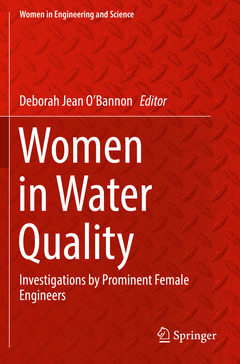Description
Women in Water Quality, 1st ed. 2020
Investigations by Prominent Female Engineers
Women in Engineering and Science Series
Language: English
Subjects for Women in Water Quality:
Publication date: 08-2020
Support: Print on demand
Publication date: 07-2019
209 p. · 15.5x23.5 cm · Hardback
Description
/li>Contents
/li>Biography
/li>Comment
/li>
This volume captures the impact of women?s research on the public health and environmental engineering profession. The volume is written as a scholarly text to demonstrate that women compete successfully in the field, dating back to 1873. Each authors? chapter includes a section on her contribution to the field and a biography written for a general audience. This volume also includes a significant representation of early women?s contributions, highlighting their rich history in the profession. The book covers topics such as drinking water and health, biologically-active compounds, wastewater management, and biofilms. This volume should be of interest to academics, researchers, consulting engineering offices, and engineering societies while also inspiring young women to persist in STEM studies and aspire to academic careers.
- Features a blend of innovations and contributions made by women in water quality engineering, as well as their path to success, including challenges in their journeys
- Presents an opportunity to learn about the breadth and depth of the field of water quality
- Includes a history of women in water quality engineering as well as research in current issues such as urban water quality, biologically-active compounds, and biofilms
Introduction.- History of women in water quality engineering.- Drinking water and health.- Use of non-potable water supplies.- Urban water quality and children’s health.- Viral outbreaks in wastewater.- Wastewater treatment.- Biologically-active compounds.- The future of wastewater management.- Stormwater and natural systems.- Metal speciation in sediments.- Biofilms.- Rain garden effectiveness.- Pervious concrete.- Conclusion.
Dr. Deborah Jean O’Bannon:
I have been active in both the American Society of Civil Engineers (ASCE) and the Society of Women Engineers (SWE): I am a Fellow in both societies. I served on ASCE’s technical committee on Hydrologic Dispersion and Transport in the 1990s, where we coordinated conference sessions. I served as the Chair of the committee in 1992-1993. I am currently (since 2006) on the Editorial Board of the ASCE Journal of Professional Issues in Engineering Education and Practice, and serve as a Corresponding Editor. I have held numerous positions in SWE, including services as a Director on the Board of Directors from 1995-1997. I later served on the Editorial Board from 2000-2014, where I initiated the Annual Review of Literature for Women and Girls in Engineering, which has become an asset to the SWE magazine and the Society. I am also involved in the capstone design community and have participated in several Capstone Conferences.

